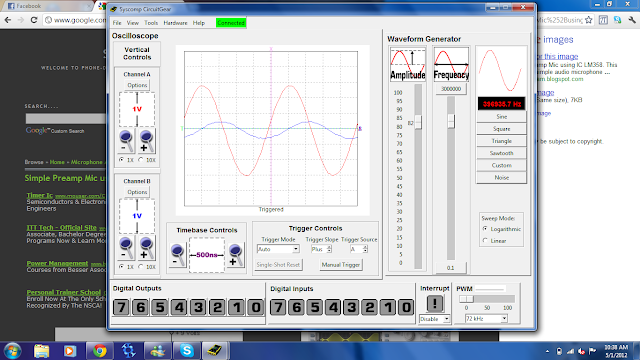Introduction
In this lab, a new circuit element called an operational amplifiers is used. As the name suggest, operational amplifier amplifies the signal of the input and it could invert or not-invert the signals. In this lab, we will use LM741 op-amps. The problems that we will tackle in this lab is a sensor whose output range is 0 to +1V has to be conditioned so that the output range between 0 and -10V. This means that the input signal should have a gain of -10. Some constraints that this lab has is that it must draw no more than 1 mA current from sensor and op-amps power supply should supply no more than 30 mW of power each.
Experimental
The first step of this experiment is to do some calculation
Since the gain have to be 10, and the max input is 1 V with 1 mA, the resistor can be calculated using
Ri = V/ I = 1/0.001 = 1k_ohm
The gain of the inverting op-amps is dictated by the equation:
gain = Rf/Ri
From this we know that Rf = 10Ri to get the gain of 10 and so
Rf = 10k_ohm
In this experiment, because of some difficulties in doing the gain of 10, we change into the gain of 5 which means the new Rf = 5k_ohm.
The circuit diagram for this lab is as follow:
In order to have the 0 to 1 V as the problems specified, voltage division is necessary and since, in this case, 7.5 V is used with power rating 1/8 W,
Rx = 8* V^2 =
450 ohm
By using voltage division method, Ry can be found to be
69.2 ohm
Since the Rx and Ry is already solved, thevenin resistance is calculated
R_th = Rx||Ry = 60 ohm
The value of the thevenin resistant in this case is about 20 times smaller than the Ri
Before building any circuit, some components were measured:
|
Component
|
Nominal Value
|
Measured Value
|
Power/Current Rating
|
|
Ri
|
1k Ω
|
.984k ±.01kΩ
|
.25W
|
|
Rf
|
5.2k Ω
|
5.14k ±.01kΩ
|
.25W
|
|
Rx
|
450 Ω
|
450 ±1Ω
|
1W
|
|
Ry
|
60 Ω
|
57.3 ±1Ω
|
1W
|
|
V1
|
7.5V
|
7.54 ±.01V
|
2A
|
|
V2
|
7.5V
|
7.66 ±.01V
|
2A
|
After the components have been measured,the circuit was then built as follow
Measurements of the circuits was then taken and tabulated below:
|
Vin
|
Vout
|
GAIN
|
VRi
|
IRi
|
VRf
|
|
0.0V
|
0V
|
0
|
0V
|
0mA
|
0V
|
|
.26V
|
-1.42 ±.01V
|
-5.46
|
.26 ±.01V
|
.26mA
|
-1.42 ±.01V
|
|
.51V
|
-2.74 ±.01V
|
-5.37
|
.51 ±.01V
|
.52mA
|
-2.74 ±.01V
|
|
.76V
|
-3.96 ±.01V
|
-5.21
|
.74 ±.01V
|
.75mA
|
-3.96 ±.01V
|
|
.99V
|
-5±.01V
|
-5.05
|
.98 ±.01V
|
.996mA
|
-5.18 ±.01V
|
Questions and Conclusions
As measured before, I1 = 1.01mA and I2=0.8mA
P_1 = I1*V1 = 1.01mA*7.54V = 7.62mW
P_2 = I1*V1 = 0.8mA*7.54V = 0.61mW
By using the op-amps as a node, need top show that I_Ri = I_Rf
I_Ri = 0.99V / 0.984k_ohm = 1.01mA
I_Rf = 5.18V / 5.2 k_ohm = 0.996mA
I_Ri = I_Rf ~ 1.01mA
We do satisfy the constraints to supply no more than 30 mW. If we want to obtain the same gain but reduce the power, we should increase the value of the resistor while keeping the ratio between the Ri and Rf to be equal to the gain.




























